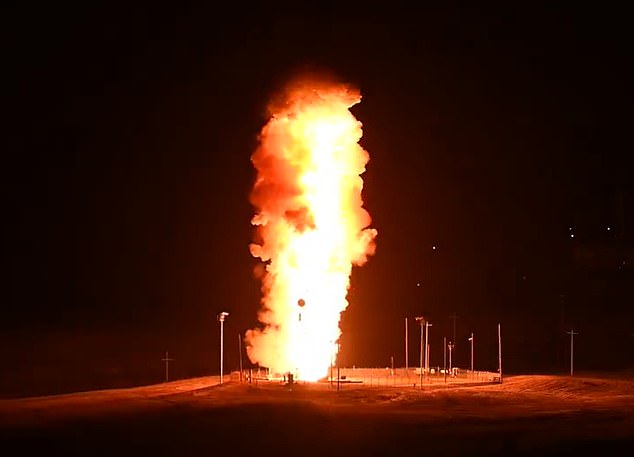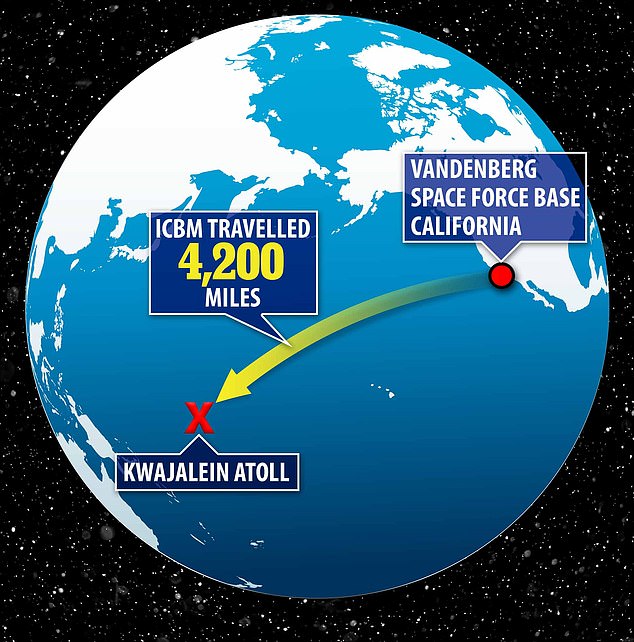US military launches hypersonic nuclear missile test hours after Donald Trump won the 2024 election
A controversial missile launch on Election Day by the US military was a success, according to officials who insist the test had nothing to do with “world events.”
The intercontinental ballistic missile exercise took place last night at 11:00 PM PT (2:00 AM ET) from the Vandenberg Space Force Base in California – just hours after Donald Trump declared victory in the presidential election.
While the timing of the launch raised eyebrows, officials emphasized that the test is routine and was planned years in advance.
Gen. Thomas Bussiere, commander of Air Force Global Strike Command, said, “These tests are a demonstration of what Striker Airmen bring to the fight when called upon by the President.
“An air launch confirms the survivability of our ICBMs, which serve as the strategic backstop to the defense of our country and of allies and partners.”
He added: “Such testing has occurred more than 300 times before, and this test is not the result of current world events.”
But the test comes as Trump claims the world is close to nuclear war and claims he will withdraw US support for Ukraine in the war with Russia before he is sworn in on January 20.
The US military conducted a test launch of its hypersonic nuclear missile on election night

The exercise began Wednesday at 11:01 PM PT (2:01 AM ET) from Vandenberg Space Force Base, California.
The nuclear missile took off in the dead of night and traveled at a speed of 15,000 miles per hour to a test range near Kwajalein Atoll in the Pacific Ocean.
It completed the 4,200 mile journey in about 22 minutes.
Military officials collected radar, optical and telemetry data in the final phase of the flight to evaluate system performance.
The weapon can carry three Mk 12A warheads, each carrying up to 350,000 tons of TNT.
While the Associated Press called Wisconsin at 2:34 a.m. (5:34 a.m.ET) on Wednesday and the PRESIDENTIAL? race just three minutes later, Newsmax made the projection about two hours earlier.
However, the official call was only made on Wednesday after Trump had collected 277 electoral votes.
Trump received more than 71 million votes as of Wednesday morning, compared to Kamala Harris’ 66 million. This makes him the first Republican to win the popular vote since George Bush in 2004.
The hypersonic weapon is designed to hit any target worldwide within just 30 minutes of launch.
Moscow is about 6,200 miles from California, while Beijing is about 6,000 miles away – the two countries were considered a threat to the US.
The test came less than a week after North Korea pledged to support Russia until its victory in Ukraine.
And just days ago, Russian Foreign Minister Sergei Lavrov warned that the US and Russia are very close to a “direct military conflict.”

The test began shortly after Donald Trump declared victory in the presidential election

However, military officials assure Americans that the test was not the result of current world events.
A report from the Wall Street Journal in May alleged that the US Marines and the Philippines had conducted ominous war games on small islands a short distance from Taiwan.
The exercises included deploying teams of Marines from Chinook helicopters, readying unarmed assault rifles and reconnaissance of terrain that would hypothetically be used if a conflict broke out.
However, military officials involved in the ICBM test assured Americans that Tuesday’s exercise was not due to growing fears of WWIII.
Col. Dorian Hatcher, deputy commander of Space Launch Delta 30, said, “This Minuteman III test launch exemplified the mission readiness, agility and professionalism of Vandenberg, Global Strike Command and the U.S. Navy personnel.
“Each test of this deterrent system at Vandenberg underscores the nation’s robust capabilities and highlights the vital support our Airmen and Guardsmen provide to ensure national security.”

The weapon traveled more than 6,000 kilometers at speeds of more than 24,000 kilometers per hour to a test range in the Marshall Islands in the central Pacific Ocean.
ICBM is one of two currently used by America; the other is submarine-launched ballistic missiles (SLBMs) deployed from underwater submarines.
The weapon is an essential part of the US military’s nuclear forces and can deliver a nuclear payload to targets around the world, but is expected to be phased out and replaced by the LGM-35A Sentinel ICBM in 2029.
The U.S. Air Force said that “the Sentinel weapon system is the most cost-effective option for maintaining a safe, secure and effective landside of the nuclear triad and would extend its capabilities through 2075.”
The LG-35A Sentinel will replace the Minuteman III ICBM with an initial capability of 2029.
Until full capability is reached in the mid-2030s, the Air Force wants to ensure Minuteman III remains a viable deterrent.
Lt. Col. Casel Rumfelt, Army Range Director, said, “This range and testing facilitates America’s technical advantage on the world stage.
“Our team brings decades of experience and a level of professionalism that makes the impossible seem easy in an environment where nothing can go wrong. I couldn’t be more proud of this incredible team.”
